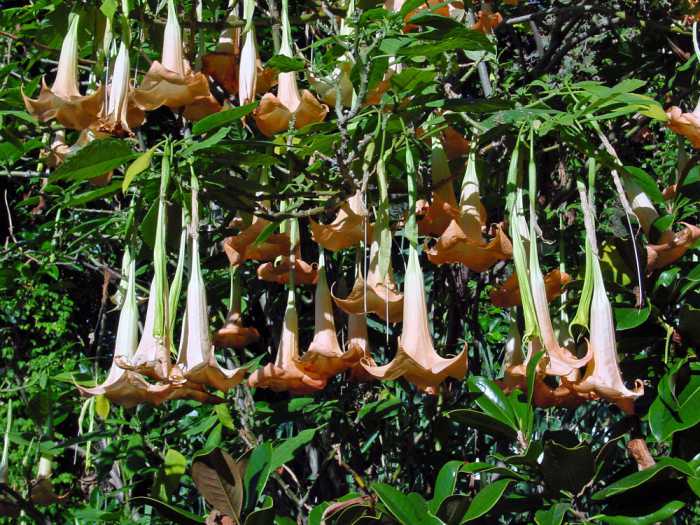Angel’s Trumpets: Alluring but…

PHUKET: While perusing old photographs of Chiang Mai, I came across some views of Doi Inthanan. This mountain, at 2,564 meters, is not only the highest in Thailand, but boasts some spectacular montane forests and flowers. At the summit, the twin Chedis appear to float, disembodied, in swirling mists that are more reminiscent of a Scottish “haar” than a tropical mountainscape.
The upper slopes of Doi Inthanon offer a perfect setting for temperate plants – lower diurnal temperatures and cooler nights – that would otherwise struggle to survive in Thailand’s hot-house environment. With more than 300 kinds of birds, there is greater biodiversity here than in any part of the country. Red rhododendrons – unique to this area of the kingdom – grow near the summit, there are two varieties of conifer found only here, and the moist hillsides provide a perfect environment for epiphytic plants such as wanda orchids, and a range of lichens, lianas, sphagnum mosses and osmada ferns.
Royal projects encourage hill villagers to cultivate cold climate crops including apples, strawberries and grapes. Lower down where the air is dryer and warmer (at the top the temperature often falls below zero), there are magnificent stands of Angel’s Trumpets. It was these that took my eye as I sauntered down memory lane. I have always loved Angel’s Trumpets, formerly called daturas, but known nowadays in botanical parlance as brugmansias.
They were one of the few tropical plants that I managed to cultivate in England where I successfully grew them in pots in my Highgate loft. A constant source of astonishment to visitors.
Moreover, they luxuriated in my Andalucian garden, which was perched precariously on a steep, rocky hillside at 300 meters.
They took readily from cuttings and quickly became leafy trees covered with masses of yellow blooms. Success has been harder to come by in Phuket. Natives of the Peruvian uplands, brugmansias need some protection from the tropical sun, and do better at higher altitudes. A pity, since they are truly spectacular shrubs with huge, pendant, tubular flowers which hang directly down from woody stems. Moreover, they are fragrant and can, as my experience attests, be grown indoors.
Perhaps you should try them as house plants in Phuket. There are now many hybrids. B. x candida is a fast grower (up to 3.5 meters tall) with dull green leaves and 20-30-centimeter-long creamy white flowers. “Double White”, from the same stable, has double blossoms and greyish foliage. Insignis, another hybrid, sometimes referred to in plant books as suavolens, has atypical trumpets that point outwards at 45 degrees from the branches. Spicily fragrant, they can be white, pink, or orange, though “Jamaica Yellow”, the variety I probably grew in Spain, has pale golden blooms.
Yet another brugmansia, B. versicolor is the variety I remember on the slopes on Doi Inthanon: the largest species, it has flowers of a peachy apricot color that hang straight down in great profusion. Plenty of choice, then, if you can locate specimens in the island’s garden centers.
If you do find potted specimens, they are likely to be in the shaded area, away from direct sun and wind. For brugmansias are quite fragile, despite the fact that they can develop into large woody shrubs or small trees. The gray branches are brittle and the blooms are tissue-paper thin. The foliage, moreover, is easily reduced to tatters by strong winds. Before new growth begins, remove all weak, dead or overlapping stems.
If you want to try your hand at growing a brugmansia in a pot, give it a large container and water regularly. Its drooping leaves will soon let you know if the soil is allowed to dry out. And as with so many members of the solanaceae family, all parts are poisonous if ingested. Angels, though alluring, are not all they seem.
Tip of the Week: Biennials and bulbs
Biennials typically complete their life-cycle in two years: they flower, seed and then die. During their first year they grow into leafy but non-blooming plants. However, those raised in nurseries usually bloom and set seed the same year.
Bulbs have specialized roots or swollen stem bases that contain an embryonic plant surrounded by scales. Think sliced onions. The bulb stores nutrients and energy for the plant’s growth. Choose ones that are plump and firm. True bulbs (eg lilies) and corms should be planted about two or three times as deep as the bulb is wide. They will need water while they are actively growing. This period begins after planting and continues until the flowers or foliage dies back. Use a nitrogen rich fertilizer to replenish depleted nutrients, both during flowering and afterwards, when the leaves are beginning to die back. Most true bulbs produce offsets which can be separated from the mother bulb.
If you have a question or a garden that you would like featured you can email me at: drpaccampbell@gmail.com. Further information about this gardening series and Patrick’s other work can be accessed at:patrickaccampbell.wordpress.com
— Patrick Campbell
Latest Thailand News
Follow The Thaiger on Google News:


























